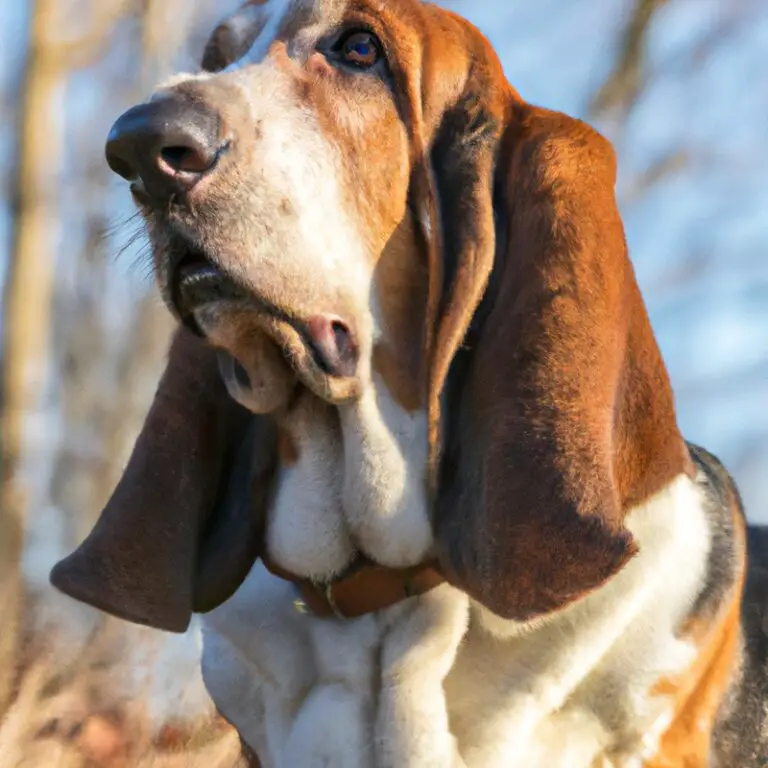How Do Basset Hounds Behave Around Unfamiliar Reptiles?
Key Takeaways:
- Basset Hounds generally show calm and curious behavior towards unfamiliar reptiles.
- Their response to reptiles may vary, but overall, Basset Hounds tend to have a mild interest rather than fear or aggression.
- It is important to supervise interactions between Basset Hounds and unfamiliar reptiles to ensure the safety of both parties.
- Familiarizing Basset Hounds with reptiles from a young age can help establish a positive and accepting attitude towards them.
Have you ever wondered how your beloved Basset Hound would react when encountering an unfamiliar reptile? As a dog lover and enthusiast, I’ve had my fair share of experiences with Basset Hounds and reptiles, and I’m here to share my knowledge with you.
In this article, we’ll explore the factors that influence Basset Hound behavior towards reptiles, provide tips for introducing them to these slithery creatures, discuss signs of discomfort or aggression to watch out for, and offer safety precautions to ensure the well-being of both your Basset Hound and the reptile.
So, let’s dive into the fascinating world of Basset Hounds and reptiles!
| Behavior | Response to Unfamiliar Reptiles |
| Curiosity | May display curiosity towards unfamiliar reptiles, sniffing and investigating them. |
| Affection | Generally friendly and affectionate towards reptiles with no aggressive tendencies. |
| Temperament | Typically calm and easygoing, which can help maintain a relaxed attitude around reptiles. |
| Caution | May show initial caution or wariness when encountering a reptile for the first time. |
| Protection | May try to protect or guard the owner from a perceived threat by signaling potential danger. |
Factors influencing Basset Hound behavior towards reptiles
Prey drive and instincts
Basset Hounds have a strong prey drive and natural instincts when it comes to chasing and hunting small animals.
This includes reptiles.
Their keen sense of smell and low, long bodies make them excellent trackers.
They may be tempted to chase or even harm reptiles they encounter, especially if they are unfamiliar with them.
It is important to be aware of this instinct and take precautions when introducing Basset Hounds to reptiles.
Proper management, training, and supervision are key to ensuring the safety of both the dog and the reptile.
Previous exposure and socialization
Previous exposure and socialization play a significant role in shaping a Basset Hound’s behavior towards unfamiliar reptiles.
Dogs that have been exposed to various people, animals, and environments from a young age are generally more open and adaptable.
Introducing Basset Hounds to reptiles at an early age, with positive experiences and supervised interactions, can help them develop a more relaxed and accepting attitude.
Additionally, ongoing socialization throughout their lives, including exposure to different types of reptiles, can further enhance their comfort level and reduce potential fear or aggression.
Remember, positive experiences and gradual introductions are key.
Temperament and personality traits
Basset Hounds have a calm, friendly, and gentle temperament.
They are known for being patient and easygoing, which can affect their behavior around unfamiliar reptiles.
Their laid-back nature often means they may not show much interest or aggression towards reptiles unless provoked.
However, it’s important to remember that every Basset Hound is unique, and individual personality traits can vary.
Some Basset Hounds may have a higher prey drive or be more curious, so it’s crucial to assess each dog’s temperament and behavior when introducing them to reptiles.
Tips for introducing Basset Hounds to unfamiliar reptiles
Supervised and controlled environment
Supervising and controlling the environment is essential when introducing your Basset Hound to unfamiliar reptiles.
This ensures the safety of both the dog and the reptile.
Make sure to keep the area secure and free from any potential escape routes.
Use a sturdy leash and have a designated area for the interaction.
Keep a close eye on your dog’s behavior and body language.
If any signs of discomfort or aggression arise, calmly redirect their attention and remove them from the situation.
Remember, it’s important to always prioritize the welfare of both your Basset Hound and the reptile.

Gradual introduction and positive reinforcement
When introducing your Basset Hound to unfamiliar reptiles, it’s important to take a gradual approach and use positive reinforcement. Start by allowing your dog to observe the reptile from a distance, rewarding them for calm behavior.
Slowly decrease the distance over time, always rewarding your dog for positive interactions.
This helps your Basset Hound associate the reptile with positive experiences. Remember, every dog is unique, so the introduction should be tailored to your dog’s comfort level.
Patience and consistency are key in this process.
Professional training and guidance
Professional training and guidance can be helpful when introducing Basset Hounds to unfamiliar reptiles.
It’s important to seek the expertise of a professional trainer who has experience working with both dogs and reptiles.
They can provide guidance on how to safely introduce the two and help modify any undesirable behaviors.
The trainer can also teach you effective training techniques and provide ongoing support throughout the process.
Their knowledge and expertise can make the introduction smoother and increase the chances of a positive outcome.
Signs of discomfort or aggression in Basset Hounds
Body language cues
Basset Hounds have unique body language cues that can indicate their comfort or discomfort around unfamiliar reptiles.
Here are some signs to look out for:
- Ears: If their ears are relaxed and hanging down, it usually indicates a calm and content state. However, if their ears are raised or stiff, it might suggest alertness or discomfort.
- Tail: A wagging tail usually signifies happiness, but a tucked tail can mean fear or unease.
- Eyes: Wide eyes, dilated pupils, or avoiding eye contact may indicate anxiety or fear.
- Body posture: A relaxed and loose body posture suggests comfort, while a tense or stiff body posture might signal uneasiness or aggression.
- Vocalizations: Basset Hounds may bark, growl, or whine when they feel threatened or uncomfortable.
Understanding and interpreting these body language cues can help you gauge your Basset Hound’s emotions and react accordingly.
Vocalizations and reactions
Basset Hounds may exhibit various vocalizations and reactions when encountering unfamiliar reptiles.
They may bark, growl, or whine out of fear or discomfort.
Some Basset Hounds may even become aggressive towards reptiles, lunging or snapping.
It’s important to pay attention to these vocalizations and reactions as they can indicate the dog’s level of distress.
If your Basset Hound is displaying these behaviors, it is recommended to seek professional help to ensure the safety and well-being of both the dog and the reptile.
Seeking professional help
If you’re struggling with your Basset Hound’s behavior around reptiles, seeking professional help can be a great option.
A trained and experienced professional, such as a dog behaviorist or trainer, can provide valuable guidance and support.
They will assess the situation, help you understand your dog’s behavior better, and develop a customized training plan.
Professional help can make a significant difference in managing your Basset Hound’s reactions and keeping both your pet and reptiles safe.
Don’t hesitate to reach out for expert advice when needed.
Safety precautions for Basset Hounds and reptiles
Separation and secure enclosures
One important aspect of ensuring the safety of both your Basset Hound and reptiles is to provide separation and secure enclosures. This means keeping them in separate areas of your home or using physical barriers to prevent any unwanted interactions.
For example, you can use baby gates or closed doors to separate the spaces.
Additionally, make sure the enclosures for your reptiles are escape-proof and securely locked to avoid any accidents. Providing a safe and secure environment is key to keeping both your pets happy and protected.

Proper handling techniques
When handling Basset Hounds around unfamiliar reptiles, it’s important to follow proper techniques to ensure everyone’s safety.
Here are a few tips:
- Approach calmly and confidently: Dogs can sense our energy, so remain calm and confident when introducing your Basset Hound to a reptile.
- Use gentle and slow movements: Quick movements may startle your dog, so move slowly and gently when handling them near reptiles.
- Avoid forcing interaction: Respect your dog’s boundaries and do not force them to interact with reptiles if they seem uncomfortable or fearful.
- Practice positive reinforcement: Reward your Basset Hound with treats and praise when they exhibit calm behavior around reptiles, reinforcing positive associations.
- Seek professional guidance: If you are unsure about proper handling techniques, don’t hesitate to seek the advice of a professional dog trainer or behaviorist.
Remember, safety should always be your top priority when introducing Basset Hounds to unfamiliar reptiles.

Monitoring and veterinary care
Monitoring your Basset Hound’s behavior and providing proper veterinary care are essential for their well-being around reptiles. Regularly observe your dog’s reactions and body language to ensure they are comfortable and not showing signs of distress or aggression.
If you notice any concerning behavior, seek professional help from a veterinarian or animal behaviorist.
Additionally, make sure to provide routine veterinary care, including vaccinations and check-ups, to keep your Basset Hound healthy and prevent any potential health issues.
Final Verdict
Understanding the factors that influence Basset Hound behavior towards unfamiliar reptiles is crucial for their safe and harmonious interaction. Prey drive, previous exposure, and temperament all play a role in how a Basset Hound may react.
Introducing them to reptiles should be done gradually, in a controlled environment, with positive reinforcement and professional guidance.
It’s important to recognize signs of discomfort or aggression and seek help if needed. Safety precautions, such as secure enclosures and proper handling techniques, are essential to ensure the well-being of both the Basset Hound and the reptile.
By following these guidelines, you can foster a positive and peaceful relationship between your Basset Hound and reptiles.







